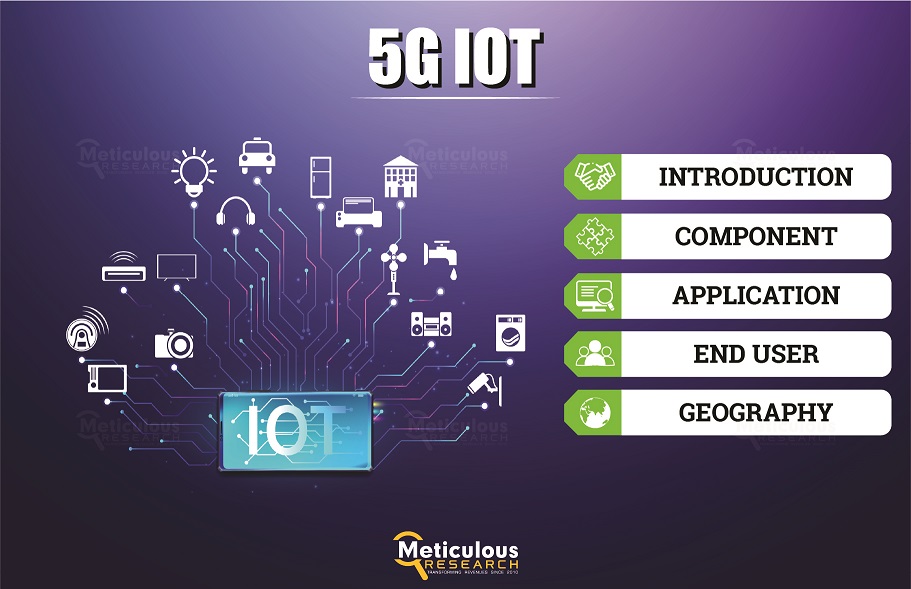
The 5G IoT Market is expected to grow to $17.68 billion by 2030, with a compound annual growth rate (CAGR) of 47.6% during the period from 2023 to 2030.
Smart cities represent a rapidly evolving urban model that integrates cutting-edge technologies, particularly 5G and the Internet of Things (IoT), to deliver connected solutions aimed at improving the quality of life for citizens, enhancing operational efficiency, and promoting sustainability. The development of 5G technology, in particular, plays a pivotal role in accelerating the transformation of urban areas into smart cities by enabling the widespread deployment of smart devices, sensors, and data-driven systems.
The Role of 5G and IoT in Smart Cities
At the heart of any smart city infrastructure are the technologies that enable seamless communication and data exchange between various devices and systems. The introduction of 5G networks offers unparalleled advantages in terms of speed, bandwidth, and low latency, which are essential for processing the vast amounts of data generated by IoT devices in real-time.
While 4G networks have supported many technological innovations, the 5G infrastructure vastly expands the capabilities of smart cities by enabling more advanced applications such as intelligent transportation systems, smart energy grids, enhanced security systems, and advanced healthcare solutions. The combination of 5G and IoT technologies forms the backbone of smart cities by providing faster data processing, more reliable communication, and the ability to handle a larger number of connected devices.
Download Sample Report Here: https://www.meticulousresearch.com/download-sample-report/cp_id=5436
Key Features of 5G IoT Devices in Smart City Development
The deployment of 5G IoT devices is a game-changer for the development of smart cities, enabling various applications that are essential for efficient urban living. Some of the most prominent features and applications of 5G IoT devices include:
– **Intelligent Transportation Systems**: 5G-enabled IoT devices facilitate real-time communication between vehicles, traffic management systems, and infrastructure. This allows for more efficient traffic flow, reduced congestion, and the potential for autonomous vehicles to operate safely in urban environments. Additionally, smart traffic lights and sensors can dynamically adjust based on traffic patterns, further enhancing transportation efficiency.
– **Smart Energy Management**: 5G and IoT technologies play a crucial role in managing energy resources more effectively. Smart grids powered by IoT sensors can monitor energy usage in real-time, allowing for better allocation of resources, minimizing energy waste, and integrating renewable energy sources more efficiently into the grid. This contributes to the sustainability goals of smart cities by reducing carbon emissions and optimizing energy consumption.
– **Enhanced Security Systems**: 5G IoT devices enable the development of advanced security systems that can monitor public spaces and private properties in real-time. Cameras, motion sensors, and other IoT devices connected to a 5G network can provide instant alerts to law enforcement or property owners in the event of suspicious activity. This helps improve public safety and reduces response times for emergency services.
– **Smart Healthcare Systems**: The healthcare sector in smart cities benefits immensely from 5G IoT devices. These devices can monitor patients remotely, providing real-time health data to medical professionals, which allows for more effective treatment and quicker response times in emergency situations. Additionally, 5G’s low latency ensures that critical data is transmitted without delays, improving the overall quality of healthcare services.
– **Public Utilities and Infrastructure**: 5G IoT devices are crucial for the efficient management of public utilities such as water supply, waste management, and public transportation. Smart sensors can monitor water usage and detect leaks in real-time, reducing waste and ensuring a consistent supply of clean water. Similarly, waste management systems can be optimized through IoT devices that track waste levels in bins and optimize collection routes.
The Internet of Things (IoT) and its Role in Smart Cities
IoT is one of the fundamental building blocks of a smart city. Simply put, IoT is a network of connected devices that communicate with each other, sharing data and information that can be used to monitor and manage various systems within a city. These devices can range from connected vehicles and traffic lights to environmental sensors and smart home devices.
The IoT enables cities to collect vast amounts of real-time data, which can be analyzed to make informed decisions on how to improve urban living. For example, environmental sensors can monitor air quality and alert city officials to pollution hotspots, while connected street lights can adjust their brightness based on the presence of pedestrians or vehicles, reducing energy consumption.
Additionally, smart buildings play a significant role in the IoT ecosystem of smart cities. These buildings leverage wireless technologies, IoT devices, building automation systems, and data analytics to optimize energy usage, monitor security, and improve overall efficiency. By using real-time data, building operators can make adjustments to heating, cooling, and lighting systems, leading to significant cost savings and reduced environmental impact.
Check complete table of contents with list of tables and figures: https://www.meticulousresearch.com/product/5g-iot-market-5436
The Impact of 5G on IoT in Smart Cities
The introduction of 5G networks enhances the capabilities of IoT devices in several ways. One of the key benefits of 5G is its ability to process and transmit data at much higher speeds than previous network generations. This means that data collected by IoT devices can be analyzed and acted upon almost instantaneously, enabling more responsive and efficient systems.
In addition to speed, 5G offers lower latency, which is critical for applications that require real-time data processing, such as autonomous vehicles or remote healthcare services. Low latency ensures that there is minimal delay between the time data is transmitted and when it is received, which is essential for applications where split-second decisions are necessary.
The increased capacity of 5G networks also allows for a larger number of devices to be connected simultaneously. This is particularly important in densely populated urban areas where thousands of devices may be operating in close proximity. With 5G, cities can deploy more IoT devices without worrying about network congestion or performance issues.
Global Initiatives and Investments in 5G and IoT for Smart Cities
Governments and companies worldwide are recognizing the potential of 5G and IoT technologies to transform urban living and are investing heavily in smart city projects. These initiatives focus on creating intelligent infrastructure, automating processes, and integrating advanced technologies to improve the overall quality of life for city residents.
For example, Siemens, a global leader in industrial automation, acquired Wattsense in 2021 to expand its building automation offerings using IoT systems. This acquisition enables Siemens to provide IoT solutions to small and mid-sized buildings, helping them operate more efficiently and sustainably.
In Canada, the government launched the “Smart Cities Challenge” in 2019, a federal program aimed at encouraging cities to adopt advanced technologies, including 5G and IoT, to enhance urban living. The program provides funding to cities that demonstrate innovative approaches to integrating these technologies into their infrastructure.
Quick Buy: https://www.meticulousresearch.com/Checkout/37538074
Report Summary:
| Particular | Details |
| Number of Pages | 325 |
| Format | |
| Forecast Period | 2023-2030 |
| Base Year | 2022 |
| CAGR | 47.6% |
| Estimated Market Size (Value) | $17.68 billion by 2030 |
| Segments Covered | By Component
By Device Range
By Architecture
By Application
By End User
By Geography
|
About Meticulous Research®
Meticulous Research® is a leading provider of comprehensive market intelligence, offering actionable insights and analysis across various industries. Our reports empower businesses to make informed decisions, drive growth, and remain competitive in a rapidly evolving marketplace.
Contact Us:
Meticulous Market Research Pvt. Ltd.
1267 Willis St, Ste 200 Redding,
California, 96001, U.S.
USA: +1-646-781-8004
Europe : +44-203-868-8738
APAC: +91 744-7780008
Email- sales@meticulousresearch.com
Visit Our Website: https://www.meticulousresearch.com/
Connect with us on LinkedIn- https://www.linkedin.com/company/meticulous-research






